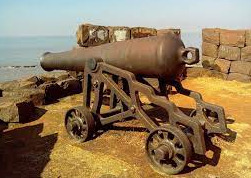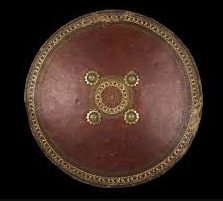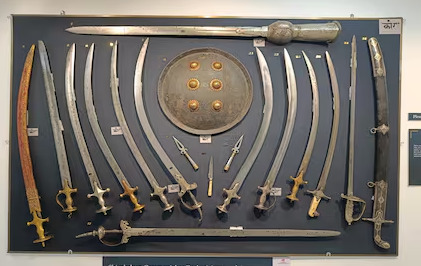Don't wanna be here? Send us removal request.
Text
Blog 36: Reflection on Pre-Production Journey
Having completed the pre-production phase, I have gained the following insights:
What Went Well:
Deep historical research connected me emotionally to Raigad.
Early blockouts reduced possible layout uncertainties.
Moodboards kept my visuals consistent.
Obstacles
Authentic references for Raigad were limited — needed creative fusion.
Balancing realism and drama took constant adjustment.
Anticipatory Assess
Start the high-polygon modeling of main structures.
Show flexibility in the conceptual development.
For motivation and final project prepping, I watched: Creating 3D Environment Art -
Creating 3D Environment Art - The Full Workflow Tutorial for Beginners
It offered valuable suggestions regarding scope management, work breakdowns, as well as the development of momentum, which are important as I move forward with modeling Raigad Fort.
0 notes
Text
Blog 35: Planning Weather, Lighting, and Mood
Meteorological Approach
Foggy mornings seen at high peaks.
Intense dry spells with high solar radiation.
Slight overcast moods near temples.
Illumination Methods
Directional light for solar radiation.
Interiors illuminated by lamps and torches.
Three-dimensional fog effects in mountainous channels.
Mood Goals:
Ancient power and nature’s dominance.
Subtle life through birds, breeze, and atmosphere.
I refined my lighting design skills through attentive observation: Faucher, William.
How to Create Red Dead Redemption-Style Lighting in Unreal Engine!
It showed how to layer directional light, skylight, exponential height fog, and LUTs for realistic mood creation. This will be instrumental in creating Raigad's dynamic and monumental atmospheric conditions.
0 notes
Text
Blog 34: Layout Plan for Camera Views and Presentation
Today, I planned the presentation of the final Raigad setting with different camera angles and possible walkthrough routes.
Planned Critical Imagery
Grand Entrance Photo from Maha Darwaza.
Courtyard Walkthrough toward the palace.
Tower View from watchtowers overlooking the fort.
Temple Close-Up capturing sacred details.
Marketplace Flythrough showing daily life.
Presentation Goals:
Create cinematic, emotional experiences.
Emphasize scale and atmosphere.
Use smooth and continuous camera movements.
To develop my competencies, I watched an excellent tutorial found on YouTube:
Unreal Engine 5 Camera Animation For Beginners In Hindi
The reading explained the notions of framing, panning shots, and focus pulls—methods I plan on using to make my walkthrough of Raigad Fort cinematic and smooth.
The systematic arrangement of these shots greatly improves the intentional depiction of spaces.
0 notes
Text
Blog 33: Color Palette and Material Guide
Today, I concentrated on creating a complete color palette and a materials guide for Raigad Fort.
Colour Palette:
Earthy Browns: For walls, ground, and houses.
Darker grays refer to basaltic lithology.
Warm Reds/Maroons: For royal spaces.
Natural Greens: Vegetation and trees.
Gold ornaments: Use sparingly for the adornments of thrones and temples.

Material Choices:
Stone: Rough basalt for fort, smoother sandstone for palace areas.
Wood: Mature dark Teak wood, found natively only in Maharashtra's timberlands.
Used were oxidized iron for artillery and purified brass for ceremonial purposes.
Materials: Fabrics made of silk and cotton for commercial and royal purposes.
Why create a style guide right now?
Avoids inconsistencies later.
It helps maintain visual consistency within the entire setting.
Ownership of this guide makes the texturing process considerably more efficient—I should thank my current self for it someday.
0 notes
Text
Blog 32: Finalizing the Asset List
I finished the overall inventory of my assets today, making sure all major elements are covered before starting detailed modeling.
Ecological resources
Perimeter defenses.
Gates (Maha Darwaza, Palkhi Darwaza, secret exits)
Watchtowers
Pathways/staircases
Palatial structures (royal hall, living quarters)
Proprietary Assets
Cannons and cannon stands
Clay pots, baskets
Wooden carts and palanquins
Weapons (swords, shields, spears)
Commercial products and displays
Temple props (bells, diyas, offering plates)
Natural resources
Trees (banyan, neem, peepal)
Ground vegetation (grasses, bushes)
Why Finalize Now?
Ensures smooth production — no surprises mid-project.
Enables tasks to be divided into controllable and separate parts.
Helps plan LOD models later if I want optimization.
Having such a detailed stock of resources lightens a huge burden from my responsibilities.
0 notes
Text
Blog 31:
Unreal Engine 5 and Nanite for Historical Worlds
Many of today's environmental artists, as emphasized through Epic's 2024 State of Unreal, are using the Nanite and Lumen features of Unreal Engine 5 to build vast, highly detailed recreations of historic environments. Several initiatives, such as the Valley of the Ancient demonstration as well as a number of unique projects, demonstrate the increased viability of using high-polygon models without compromising performance. For Raigad Fort, this excites me because I can model detailed bricks, broken stones, rough terrain, and still maintain good FPS. Watching the development of vast medieval cities by independent groups using Nanite gives me confidence in the feasibility of my project's specifications. Inspiration gained through recent protests will push me.
0 notes
Text
Blog 30:
Black Myth: Wukong (Game Science, 2024 Trailers)
The newest Black Myth: Wukong promo videos from Game Science feature fantasy environments that are strongly rooted in real historical and cultural backgrounds—a facet that is especially relevant to Raigad Fort. Their handling of ancient architecture, weathered temples, mist-covered mountains, and mythical creatures balances realism with a quiet form of stylization. While Raigad is of significant historic significance, the way that Wukong decorates decaying buildings and uses evocative narrative style is a method that I would love to imitate within my own work. Their material detailing — old mossy stones, broken statues, flowing fabrics — show how aged environments can still feel majestic. Seeing the development of Wukong has made me want to make Raigad be not just "accurate" but also "lively and magical" using strategic lighting and materials.
0 notes
Text
Blog 29:
Sucker Punch’s Ghost of Tsushima Director’s Cut (2022 PC Launch)
The Ghost of Tsushima Director’s Cut PC release (2022) reignited my love for environment-led storytelling. Sucker Punch created lush, cinematic landscapes that reflect history but maintain artistic drama. The extensive scenery, rolling greens, and fog-shrouded mountain roads of Ghost are instant inspirations for my project regarding Raigad Fort. Affective profundity within historical contexts was accomplished through the incorporation of atmospheric components, color variations, and spatial configurations—methodologies that I intend to apply particularly to temple courtyards and fortifications. Also, their use of minimalist UI and immersive world design (no map markers, follow the wind) influences how I want my Raigad environment to feel "explorable" without needing extra instructions.
0 notes
Text
Blog 28:
Ubisoft's Work on Assassin’s Creed Mirage (2023)
I was impressed with Ubisoft's Assassin's Creed Mirage (2023) because of its detailed portrayal of historic Baghdad. The artists were outstandingly able to represent architectural accuracy; each courtyard, arch, and alley seemed genuine as well as aesthetically enhanced. For Raigad Fort, I'm heavily inspired by Mirage’s approach: blending historical accuracy with gameplay-friendly layouts. The complex cityscapes, winding narrow streets, and colorful bazaars of Mirage are a model for the planned uses of the interior areas of the fort, including both business districts and residential areas. The utilization of rich, earthy colors together with dramatic changes in lighting throughout the day largely impacts my design style for Raigad. By analyzing Mirage, the goal is to discern a harmonious balance of visual complexity with fidelity to history.
0 notes
Text
Blog 27:
Learning from Naughty Dog: How Environmental Storytelling Will Shape Raigad
Naughty Dog's recreation of The Last of Us Part 1 was a strong source of inspiration for my Raigad project. The re-imagining emphasized real locations through the application of environmental storytelling, using dilapidated buildings, vast cityscapes, and abandoned cars to create a richly detailed world with no voiceover.
While reconstructing Raigad Fort, I plan to use similar techniques, involving such things as dismantled cannons, crumbling stone steps, and overgrown vegetation to tell stories of decay and survival. I enjoyed how Naughty Dog continued with a narrative-driven design, skillfully guiding players using perceptive environmental cues. My goal is to achieve this by establishing the routes and entry points of Raigad in a way that quietly focuses the player's attention without compromising the natural ambiance. The quality of materials like wood, metal, and stone will provide a benchmark which I will assess systematically throughout the texturing process.
0 notes
Text
Blog 26: Prop – Cannons and Fort Defenses
The pictures done today focused on fortifications including catapults, cannons, and barricades.
Key Cannon Design Elements:
Important, independently operated artillery installations with revolving bases.
Stone or wooden platforms for cannon stands.
Reinforced cannonballs and gunpowder barrels stored nearby.
Supplementary Protective Measures
Wooden barriers blocking roads.
Spiked traps near hidden entrances.
Signal fire structures for communication.
Design Considerations:
Cannons should show signs of aging and thorough use, including broken wood, rusted metal, and eroded stone foundations.
Barricades need to look usable but crude, lacking any need for complicated forms of sophistication.
The initial design of props enables their smooth incorporation into the environment, thus enhancing narrative development (e.g., the fort was built for real combat situations).



0 notes
Text
Blog 25: Collecting Vegetation References
Today was all about vegetation research — critical for creating a believable 17th-century Maharashtra landscape.
Investigation Focus
Types of Trees: Banyan, Peepal, Neem
Thorny bushes and clusters of arid-season grass.
Ground Cover: Dry rocky plains, withered leaves, scattered vegetation.
Near sacred buildings, it is common to see Marigold and Tulsi plants.
Vegetation Style:
With a fairly dry and rugged terrain, Raigad stands upon a high plateau that gets much sunshine.
Dispersed positioning — nature's intrusion into stone buildings, a sign of ageing.
I collected photo references and botanical drawings for accurate leaf shapes and colors. Vegetation will bring subtle life and contrast against the stone-heavy architecture.
0 notes
Text
Blog 24: Initial Blockout – Fort Walls and Pathways
I went ahead today to present a general overview of the fortifications as well as internal passageways.
Methodology Utilized
Used basic low-polygon walls to mark the perimeter of the fortress.
Engraved, wavelike roads rise up steep sloping terrain—an authentic strategy used to deter invaders.
Created enclosed squares and community spaces within the fortified complex.
Important Considerations:
Trails should not look like perfect city streets; instead, they should be natural and shaped by the irregular topography.
Some of these routes will have staircases carved straight from the mountainside.
Fort walls should have irregular angles — not perfect squares.
Blocking early like this helps test how the player (or camera) will navigate the space naturally.

0 notes
Text
Blog 23: Watchtower Designs
Today’s focus was on concept for watchtowers (also called "Buruj" in Marathi).
Theoretical Representation
Circular Towers: Strong against cannon fire, visually more dramatic.
Square Towers: Easier to build but historically more vulnerable.
Multi-level Towers: For better long-distance views.
Details Added:
Compact, curved apertures for surveillance purposes.
Battlements at the top for defense.
The stone textures associated with the fortifications are largely basalt rock.
Functional Thinking:
Watchtowers placed to oversee key pathways and entrances.
Signal flags or fire pits on top for long-range communication.
Sketching options now helps avoid repetitive tower designs later — and shows how the fort was a true defensive masterpiece.


0 notes
Text
Blog 22: Fort Gate Variations
The Maha Darwaza is the main gateway, while several minor gates exist; Raigad was traditionally marked by hidden ways and unknown exits.
Gate Types:
Maha Darwaza: An imposing ceremonial gateway; bastioned and well-guarded.
Palkhi Darwaza: Smaller, used by royal family.
Mena Darwaza: A hidden, secret exit.
Different door shapes (arched vs straight).
Decorative elements — simple carving for royal gates, plain for secondary ones.
Different defensive features—flanking bastions, murder holes, and narrow passages.
Why Variations:
Presents a number of options before finalizing a design.
Adds visual variety across the fort.
Each of the five entrances has a particular justification and a special significance.



0 notes
Text
Blog 21: Prop Research – 17th Century Maharashtrian Objects
Props make an environment feel alive and believable. Today I researched typical everyday objects from 17th-century Maharashtra to add authenticity.
Acknowledgments regarding Raigad.
Household Items: Earthenware water pots (matkas), brass lighting fixtures (diyas), and straw woven mats (chatais).
Armament: Lances, knives, defensive barriers, bows.
Market Goods: Jars of cereals, agricultural items, and spices.
Temple Offerings: Flower arrangements, small brass bells, oil lamps.
Conveyance Means: Hand-drawn carts, palanquins used for royalty members.
Visual Features:
Handmade, not mass-produced.
Organic materials — soil, wood, metal alloy, fabric.
Worn look — items should show use, wear, weathering.
Collecting this reference now ensures the Raigad world feels lived-in and rich with history — not sterile or generic.
0 notes
Text
Blog 20: Reference Analysis – Games Set in Historical India
For style and atmosphere ideas, I researched games/movies that portrayed ancient/medieval Indian settings.
Principal Citations
Raji: An Ancient Epic (2020): Great reference for Indian architectural details, though it's more fantasy-inspired.
Assassin’s Creed Chronicles: India (2016): Stylized, but brilliant for color palettes and textiles.
Prince of Persia (Sands of Time Trilogy): Middle Eastern-inspired, but similar in fortresses, pathways, and palace structures.
Baahubali Movies: Epic-scale Indian historical-fantasy; brilliant reference for fort design, palace interiors, and battle scenes.
Observations I Made:
Balance between realism and drama — you want things believable but still slightly heightened for impact.
Dominant vertical elements are long towers, wide entryways, and long staircases.
Dense use of natural colors with royal accent colors (just like my color scheme!)
Using these sources will help create a cinematic feel for Raigad Fort without straying from historical influences.
0 notes